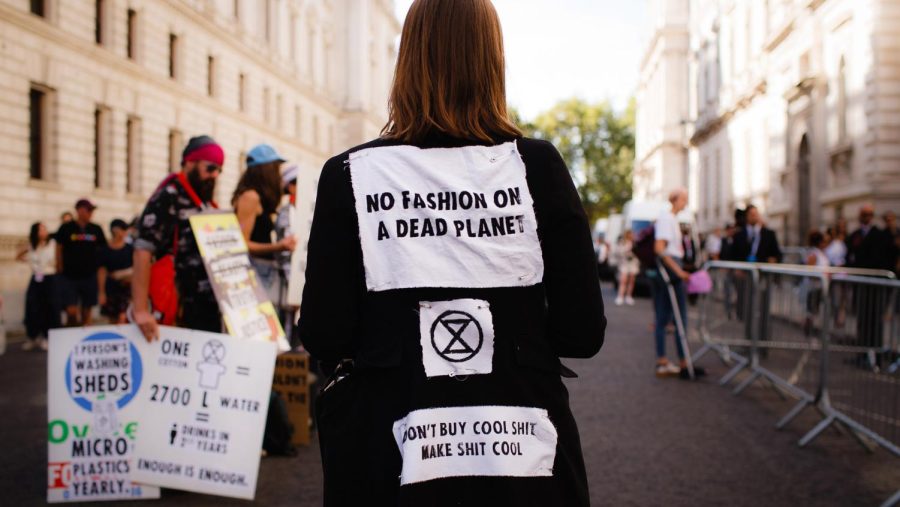Can sustainability be made chic?
Sustainability efforts at NY Fashion Week attempt to reconcile sustainability and fashion
A protestor wears anti-fashion messages on their clothes.
October 12, 2022
Each September, one of the biggest celebrations of fashion and consumption takes place in some of the most iconic spots in New York. The Council of Fashion Designers of America (CFDA) organizes a grandiose event known as New York Fashion Week, and every year the industry’s negative environmental impact puts the CFDA in the spotlight. Although the CFDA aims to reach net-zero greenhouse gas emissions by 2050, achieving this goal would mean designers have to produce a smaller amount of product and earn less revenue..
But some designers and environmental activists have started to push for a reassessment of their sales and competition policies. There has been some discussion about overhauling the fashion calendar in order to reduce waste and increase efficiency. Some proposals include limiting sale periods and changing the length of seasons. However, efforts to fix prices and reduce production could be risky since antitrust laws prohibit competitors from working together to reduce production. The tension between environmental consciousness and economic competition is now at a standstill. As the pressure to utilize more environmentally friendly methods continues to escalate in the fashion industry, activists doubt that their aspirations will ever become a reality.
They doubt it because fashion shows spark trends and overproduction that are becoming more and more unsustainable. One may ask themselves, why are people still hosting and supporting such extravagant shows? I know I have. Although Fashion Week only represents a small part of the negative impact that the fashion industry is having on our environment, it has displayed and encouraged wrongful practices and systems.
To think that some of the beautiful outfits worn by the runway models are torn down and dumped in a land-fill after a forty-five-minute show — what a waste! Not to mention the attendees’ luxurious means of transportation; from first-class plane rides to their private drivers. Every detail of opulence greatly contributes to the monstrous collective carbon footprint during Fashion Week.
It should be mentioned that some efforts are being made to lessen this substantial carbon footprint created by Fashion Week and its industry. Designers are beginning to reuse and recycle runway materials. Many of them are also spreading the word on the importance of a sustainable Fashion Week and industry alongside activists. Big fashion companies like Patagonia and Levi’s are also taking an initiative to implement more sustainable methods in the production and distribution of their products. Patagonia helps clients mend existing clothing rather than purchasing new items. Levi’s new collectisuston, Water, is committed to using cotton that is 100% sustainably produced and recycling old jeans for home insulation. Hopefully, a shift towards a more sustainable approach to fashion will ensue after these efforts by Patagonia and Levi’s. The CFDA is also trying to come up with ways to make its events less costly and environmentally damaging.
Although these gestures and promises may be satisfying to the public for now, the reality is that runway shows during events like New York Fashion Week are still harming our world by releasing harmful gas emissions and other pollutants. Instead of making so many empty promises that will supposedly come true by 2050, designers, retailers and big fashion companies should prioritize the environment and drastically reduce their CO2 emissions and waste by implementing more sustainable methods, even if it means a lower amount of production and gains. Moreover, these fashion industries should be taking action now, rather than prolonging the process until 2050. Fashion is constantly evolving — its sustainability and impact on the environment should too.












